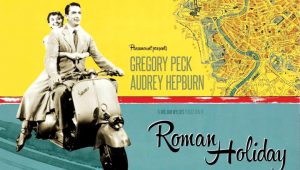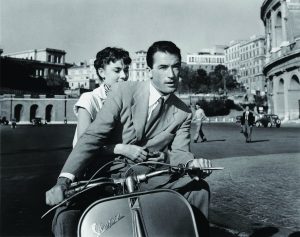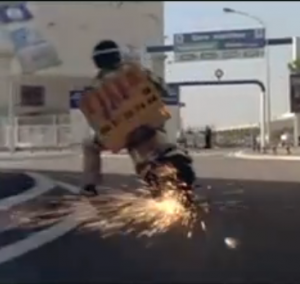Occasionally you get a vehicle in a movie or television show that is more than just a prop – in some cases they are so well used, so visually striking, or so important to the plot they become a character themselves.
Occasionally they become more important than the other characters, or even the movie itself.
These pop-culture creations have led more than one into the world of scooter ownership, often planting themselves into our subconscious in ways we don’t fully appreciate until we obtain our licenses and purchase our first roadworthy machines.
Which only makes sense – after all scooters are the ultimate in fun, casual transportation and I for one can admit to making the occasional “Vroom” noise, or to humming the occasional theme song while driving down the road.
This brings us to the topic of this article – Scoottoronto’s picks for our favourite Scooters in Pop Culture:
Roman Holiday: 
Arguably the machine brand that brought the concept of a scooter to the public consciousness is the Vespa. The Vespa was designed in post-war Italy as a modern and affordable machine for the masses – and the 1953 movie “Roman Holiday” with Gregory Peck and Audrey Hepburn did much to cement the image of the Vespa scooter as a symbol of freedom for the

average person, and in some ways it helped established the common perceived “look” of what a proper scooter should be: curved lines, a legshield, the engine covered to keep (in theory) grease and dirt away from clothing. It was the beginning of the hop on and go vehicle, the urban commuter. This was a change from both the perception and reality of earlier machines, with early motorcycles being dirty, unreliable, and harder to use. (Early motorcycles often had a total loss oil system for example, where oil was pumped from a tank through the engine and then basically lost from the engine – resulting in oil going onto the machine and road. )
Roman Holiday is the story of a sheltered princess who through a series of mischances meets a journalist who takes her on a holiday on the Vespa through Rome. Her journey becomes something of a brief escape from a structured and constraining life, and the scooter becomes a symbol of freedom among a life bound by tradition and public perception. In a postwar era where the motorcycle is often viewed with a disreputable eye, the Vespa (assisted by it’s appearance in Roman Holiday) became a symbol of freedom without the baggage, and in many ways set the stage for the media campaign that would completely change the perception of the scooter – Honda’s “You meet the nicest people on a…” campaign.
For this reason alone, Roman Holday deserves a first place mention on this list of Pop Culture scooters.
The Akira Motorcycle:
From metal to plastic, from the 40’s to the 80’s, and from Europe to Asia – the next important machine we have to mention is the motorcycle from Akira.

This one may generate some debate. After all, many would argue this is a motorcycle instead of a scooter – but the design itself is clearly a step-thru based chassis, lacks any kind of visible shifting and has what appears to be a plastic or composite body with a fairing around the front of the rider. It even has some design cues you might spot in some maxi-scooters of the modern day, which isn’t surprising considering many motorcycle designers probably grew up having watched Akira and having the motorcycle scenes burned into their subconscious.

Akira was a 1988 japanese anime film – and is a huge landmark in Japanese Animation. Set in a dystopian 2019 (Which sadly seems appropriate given the way the world is headed, though hopefully we won’t get there in the next year or so) the film resolves around the leader of a biker gang whose friend develops strange powers amidst the sprawling futuristic metropolis of Neo-Tokyo.
When Akira came out – and when you first saw the race scenes of the animated motorcycle – it was an impact to senses. Akira changed how animation was perceived – with darker, nuanced themes and comments on society and human nature alike. The motorcycle itself is less of a prop in the film and more of a character in and of itself – spawning real life replicas (generally using a maxi-scooter as the base, which I’ll add to my argument that it is a scooter) such as this one.
This machine is important for a whole generation of motorcyclists and scooters who – likely before they even had a license – saw the machine and saw a vision of motion and colour in a stage set from crumbling concrete and a storyline shocking in the themes being presented. Once again, the machine became a character in a film and the machine is quoted in unverbalized engine noises, a twist of throttle, and the motorcyclist unconsciously riding the back streets of Neo-Tokyo.
It was shocking, it was impractical, it was a sign of the future and for all of these reasons and more the Akira motorcycle made this list. For reasons that should be obvious to anyone who has ridden a red plastic covered machine and yelled out “Tetsuo!” – even if it was in the back of their heads.
Taxi:
The scooter is this movie isn’t really a character.

Actually, scooters only really end up being in the first part of the film at all – but the sheer frenetic, crazed, frantic and dangerous traffic dodging stunt scene that starts off the 1998 Luc Besson film “Taxi” makes this worthy of mention.
Filmed in one long chase sequence, the stunt rider pushes the limits (and just a touch beyond) of traction. The limits of good sense are left far behind, and the limits of sanity are in an entirely different postal code.
“Taxi” is a comedy/action film in which the hero of the film is a pizza delivery rider (hence the scooter that the film starts out with) who has finally saved up enough money to purchase his own taxi and is retiring as a pizza delivery rider.

As you might guess, his taxi driving shows many of the many sensibilities of the crazed opening scooter riding sequence, and things go somewhat downhill from there – but I’m not going to spoil the film as aside from the opening scooter stunt sequence the film is well worth watching right through.
“Taxi” shows that the humble, everyperson scooter can be a weapon of vehicular destruction. It plays with the notion of what you use for an action vehicle sequence, and keeps you riveted with a single driver, no chase sequence, no gunfight, and a lack of dialogue during the majority opening scooter scene.
For making a scooter into a stunt hero, this also deserves to make this list – and we recommend the rest of the film as well.
(You likely can find the opening sequence on youtube should you want to look just for that bit, but we’re not going to link it here.
Let us know in the comments what scooter pop culture influenced you – be it Quadrophenia or Larry Crowne (two other films we may add into a part two, each for very different reasons.) We’d love to hear if a particular machine on little or big screens caused you get have a fascination with our two wheeled machines, and if that is what led you into the dark arts of scootering. (At least dark for me, I can’t keep stains off of light coloured riding gear.)
